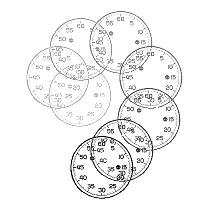 We know all about the theory espoused by Roger Penrose and Stuart Hameroff, that consciousness is generated by a novel (and somewhat mysterious) form of quantum mechanics which occurs in the microtubules of neurons. For Penrose this helps explain how consciousness is non-computational, a result he has provided a separate proof for.
We know all about the theory espoused by Roger Penrose and Stuart Hameroff, that consciousness is generated by a novel (and somewhat mysterious) form of quantum mechanics which occurs in the microtubules of neurons. For Penrose this helps explain how consciousness is non-computational, a result he has provided a separate proof for.
I have always taken it that this theory is intended to explain consciousness as we know it; but there are those who also think that quantum theory can provide a model which helps explain certain non-rational features of human cognition. This feature in the Atlantic nicely summarises what some of them say.
One example of human irrationality that might be quantumish is apparently provided by the good old Prisoner’s Dilemma. Two prisoners who co-operated on a crime are offered a deal. If one rats, that one goes free while the other serves three years. If both rat, they serve two years; if neither do, they do one year. From a selfish point of view it’s always better to rat, even though overall the no-rat strategy leads to least time in jail for the prisoners. Rationally, everyone should always rat, but in fact people quite often behave against their selfish interest by failing to do so. Why would that be?
Quantum theorists suggest that it makes more sense if we think of the prisoners being in a superposition of states between ratting and not-ratting, just as Schroedinger’s cat superimposes life and death. Instead of contemplating the possible outcomes separately, we see them productively entangled (no, I’m not sure I quite get it, either).
There is of course another explanation; if the prisoners see the choice, not as a one-off, but as one in a series of similar trade-offs, the balance of advantage may shift, because those who are known to rat will be punished while those who don’t may be rewarded by co-operation . Indeed, since people who seek to establish implicit agreements to co-operate over such problems will tend to do better overall in the long run, we might expect such behaviour to have positive survival value and be favoured by evolution.
A second example of quantum explanation is provided by the fact that question order can affect responses. There’s an obvious explanation for this if one question affects the context by bringing something to the forefront of someone’s mind. Asking someone whether they plan to drive home before asking them whether they want another drink may produce different results from asking the other way round for reasons that are not really at all mysterious. However, it’s not always so clear cut and research demonstrates that a quantum model based on complementarity is really pretty good at making predictions.
How seriously are we to take this? Do we actually suppose that exotic quantum events in microtubules are directly responsible for the ‘irrational’ decisions? I don’t know exactly how that would work and it seems rather unlikely. Do we go to the other extreme and assume that the quantum explanations are really just importing a useful model – that they are in fact ultimately metaphorical? That would be OK, except that metaphors typically explain the strange by invoking something understood. It’s a little weird to suppose we could helpfully explain the incomprehensible world of human motivation by appealing to the readily understood realm of quantum physics.
Perhaps it’s best to simply see this as another way of thinking about cognition, something that surely can’t be bad?

 Libet’s
Libet’s